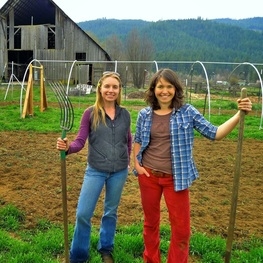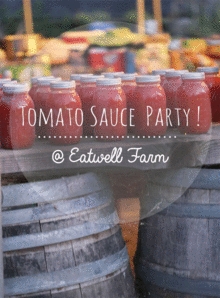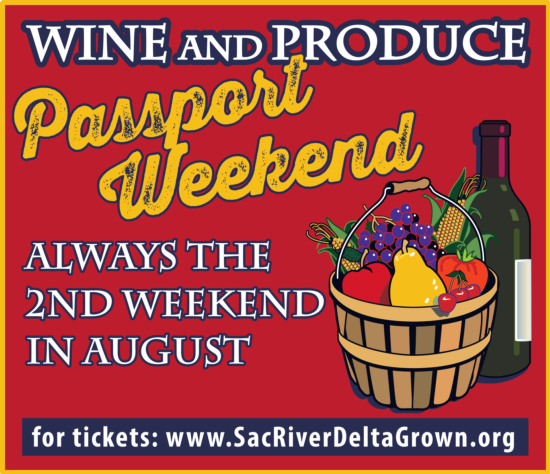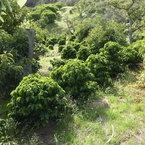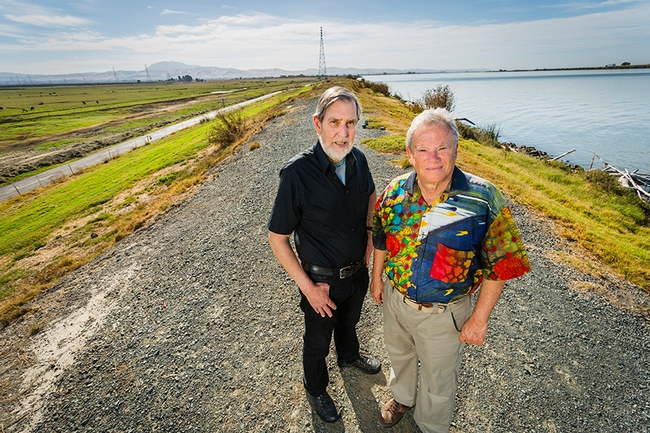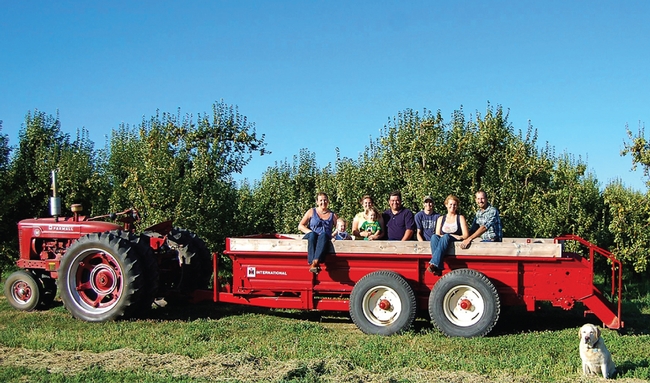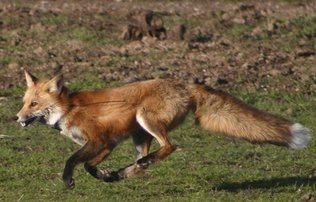Posts Tagged: Sacramento
Summer farm fun
This time of year, most farmers don't get much sleep. Tomatoes, pears and peaches often ripen in the Sacramento Valley faster than the harvest crews can pick them, even working 12-hour days. But this is also the season that some farmers are happy to show off their farms to visitors, inviting guests to enjoy the delightful flavors and beauty of the harvest in a pause from the bustle. UC Cooperative Extension hosts an online agritourism directory and calendar, www.calagtour.org, to help Californians find farms and ranches to visit. Here are a few upcoming opportunities for summer fun on California farms, pulled from the calendar:
- Plumas County Farm Crawl - Up the Feather River Canyon, on the eastern side of the Sierras, are the beautiful communities of Quincy and Indian Falls. Small-scale growers, members of Plumas Grown, offer tours and fresh snacks from their fields from 8 a.m. to 12 p.m. on Saturday August 6, 2016. Each farm will offer tours on the half hour (8:30, 9:30, 10;30 and 11:30). Participating farms include a school garden project, Five Foot Farm, Shoofly Farm and Sundberg Growers. Strawberries, tomatoes, garlic, carrots, huge heads of lettuce, hoop houses, and intense cultivation on small plots will be featured. Bring the kiddos, friends and family (no dogs please). All of these operations use sustainable growing practices and are happy to chat with you about why they love to grow good food. Admission by donation, no pre-registration required. Learn more: (707) 217-6415 or www.plumasgrown.com/
- Good Humus Peach Party (Yolo County) - Every year on the first Saturday in August, Jeff and Annie Main, owners of 20-acre Good Humus Produce, hold a celebration to give thanks for the year's fruit harvest. They invite you all to come out, see the farm, have a refreshment and enjoy all that Good Humus has to offer. This is a pot luck party; guests are asked to bring a dish to share and their own plates, silverware and cups. No cost, but donations are welcomed. The Mains will provide peach pies, peach ice cream, peach salsa, peach pizzas, and more. You are invited to come early and be part of the experience of making all the peachy fun food. Other activities include a treasure hunt, farm tours, stock tank dipping, music and neighborly chat. Saturday August 6, 1 p.m. - 11 p.m. Learn more
- Tomato Sauce Party at Eatwell Farm (Solano County) - It's time to join in on the tradition. Let's get canning! Tomato season is in full swing on the farm, and the plants are bursting with ripe and juicy tomatoes ready for picking. Join us as we harvest the bounty of the farm, toss it in a pot, and create delicious tomato sauce to savor the rest of the year. The produce is free, so bring as many jars as you can process over the two day event. The ticket price covers the cost of hosting the event and paying staff. Cost: adults $20, Children $5. August 6 - 7, 2016 Learn more and buy tickets here
- Grape Days of Summer (Placer County) - Celebrate PlacerGROWN — local wine, local food, local agriculture. Take a self-guided tour of up to 20 wineries, taste foothill wines and enjoy a unique and educational experience at each stop on the Placer County Wine Trail. Saturday & Sunday, August 6 & 7, 11 a.m. to 5 p.m. WHERE: Placer County Wine Trail - Auburn, Lincoln, Loomis, Meadow Vista, Newcastle & Rocklin. Activities: Learn About Wine & Wine Making • Live Music at Some Locations • Food at Every Winery • Barrel Tastings • Vineyard Tours • Vertical Tastings • . . . and more! Tickets: Weekend Pass - $45.00, Sunday Only - $25.00/person, Designated Driver - $10.00/person website, more info
- Wine and Produce Passport Weekend (Sacramento River Delta) - Just minutes from Sacramento and Elk Grove, along scenic CA Hwy 160, Delta Farm and Winery Trail members will open their farms and wineries to the public. Farms are open from 9:00 a.m. to 5:00 p.m. and wineries from 11:00 a.m. to 5:00 p.m. During Passport Weekend, enjoy farm tours, local wine tastings, farm equipment displays, and contests. Fresh produce - including tomatoes, pears, melons, squash, stone fruits, sweet corn, zucchini, beans, eggs, and organic produce - will be readily available at many of the farms. Saturday and Sunday August 13 and 14. Tickets: adults $25 in advance, $35 week of purchase and are valid for both days. Kids under 21 are free. Tickets are available for purchase online at www.deltapassport2016.eventbrite.com. Each visitor over 21 will receive a wine glass at their first winery stop. sacriverdeltagrown.org/
- Good Land Organics Coffee Tour (Santa Barbara County) - The tour will be lead by Good Land Organics owner and grower, Jay Ruskey. You will be welcomed with fresh coffee, freshly made juice and seasonal fruit. Jay will give an overview of the coffee research collaboration that has been conducted with the assistance of the University of California Small Farm Program. He will then lead you on a moderate level hike where Ruskey will explain the dynamics of new crop adaptation and integration of organic tree fruit agriculture. The walk will take you through the eclectic mix of exotic fruit varieties that grow on the farm. Each person will have an opportunity to taste a fresh picked coffee berry and discover the original flavors of the coffee bean, while discussing coffee cultivation and post harvest processing. On your return hike, there will be time for open discussion and for any further questions. At noon you have the option to enjoy your picnic lunch at our pond. August 13, 2016, 10:00 a.m. - 1:00 p.m. Cost: $50 per person. website, reservations
Learn about more farms, ranches and adventurous fun at www.calagtour.org.
Farmers learn, connect, tour and taste in Sacramento
Running a small-scale farm or ranch isn't easy; it requires hard-learned skills, innovative marketing and a supportive community. Farmers and ranchers from all over California will join with farmers' market managers, educators, small farm advocates, and some of the most creative of Sacramento's Farm to Fork chefs at the California Small Farm Conference, held this year at the DoubleTree Hotel in Sacramento from March 5 to March 8, 2016.
For three days, about 400 attendees will join workshops, explore with field courses, network with colleagues and enjoy a few social events. The now-annual conference was started by the UC Agriculture and Natural Resources (UC ANR) Small Farm Program in 1982 as a unique opportunity for small-scale farmers to learn, network and grow their businesses. UC ANR specialists, advisors and staff continue to contribute to the conference as members of the board of directors and as educators presenting science-based information at workshops and field courses.
The conference offers workshops in five different themes. This year, among many other speakers, UC Cooperative Extenison (UCCE) small farms and agricultural economics advisor Ramiro Lobo will lead a workshop on risk management strategies for farm enterprise diversification; Alda Pires, UCCE Cooperative Extension specialist in urban agriculture and food safety, will speak at a workshop on food safety on bio-diversified small-size farms and the FSMA Produce Safety Rule; and UCCE advisor Paul Vossen will teach about both growing cider apples in California and irrigation management for olive growers in a time of drought. In addition to UC and other educators, each of the 25 workshop sessions includes the perspective and practical experience of at least one small-scale farmer or farmers market manager.
Sunday, March 6, features all-day field courses and short courses, giving participants a chance for deeper understanding and multiple perspectives as they explore their choice of four different topics. Two of the courses this year will be led by UC ANR educators or staff.
For the on-site short course, "Starting a SUCCESSFUL Specialty Food Business," Shermain Hardesty, a UCCE specialist in the Department of Agricultural and Resource Economics at UC Davis (and leader of the UC Small Farm Program) teams up with Linda Harris, a UCCE specialist in Food Safety and Microbiology at UC Davis, Dan Sullivan, a specialty food business expert and specialty food producers, Jason Poole of Preservation & Co. and Courtney Smith of Bloomingcamp Ranch. UCCE Agritourism Coordinator Penny Leff will lead a field course named, "Direct Marketing: Farmers' Markets, Farm Stands, U-Pick and Wine Tasting," that will visit and learn from some of Sacramento region's expert practitioners of these various direct marketing venues.
Sacramento region food and beverage fans are invited to attend the "Taste of Sacramento" Tasting Reception on Monday, March 7, from 5:30 to 7:30 p.m. The Tasting Reception is the culinary and social highlight of the California
Small Farm Conference and showcases the beautiful bounty of the region. Attendees will taste the creations of Sacramento's best Farm-to-Fork chefs, brewers, winemakers and artisan food and beverage producers. Local farmers, including Riverdog Farm, Full Belly Farm, Heavy Dirt Farm, Dragon Mushrooms, and others are providing meat and produce for the chef's cook-off contest (you vote for your favorite) featuring chefs from Mulvaney's, Magpie Cafe, Localis, Federalist Public House, the Culinerdy Cruizer, and Sacramento's Food Literacy Project. Proceeds ($50 ticket - purchase here or at the door) support the Small Farm Conference scholarship program.Online registration for the conference has now closed, but on-site registration is welcome! For more information, see the California Small Farm Conference website, or phone (888) 712-4188. See you there!

Photo of Guido Frosini, True Grass Farms, by Janae Lloyd, a winner of the farm conference 2015 photo contest.
California’s delta: On the front lines of the state’s water issues
California water: Few natural resources are as impressive, or as imperiled. Whether it's supplying 40 million domestic users, cooling the server farms of Silicon Valley, or irrigating the actual farms that supply half of the nation's produce, the importance of the state's aquifers and headwaters cannot be overstated. (Lake Tahoe, Yosemite Falls, and white-water rafting on the Kern and American Rivers feel like an embarrassment of riches.) While the potential for a multi-decade drought has grabbed headlines, however, California's water supply faces assault from a host of lesser-known factors including infrastructure failure, pollution, habitat loss, and plain old political chaos. This issue is strongly interdisciplinary, so it's only natural that UC Berkeley College of Natural Resources professors and students have been at the forefront of analyzing the problems and beginning the search for solutions. Several Berkeley professors have even served on the Delta Independent Science Board (DISB), a group of experts appointed by the state to oversee the quality of scientific research on California's contentious delta water issues.
Supply vs. demand
“Issue number one, one, and one is that a substantial portion of the acreage in agriculture is supported through groundwater overdraft, even in normal-rainfall years,” he says.
According to the U.S. Geological Survey, California's cities, factories, and farms soak up about 38 billion gallons every day. And while most people think of water in terms of rivers, lakes, and rain, over a third of the state's supply comes from aquifers deep underground. Only one in six Californians relies on groundwater alone to supply their domestic needs.
“We've been mining water to expand use beyond surface-water allocations,” says Norgaard. “Groundwater is close to gone, and agriculture is saying, ‘Where's our water, where's our water, where's our water?'”
Given that much of California is a desert — and that decades-long droughts are not impossible — intelligently managing California's limited supply is crucial. Gov. Jerry Brown recently ordered municipalities to cut home water usage by a whopping 25 percent, and California residents gave themselves a well-deserved pat on the back when usage for July 2015 surpassed that target by 6 percent. But there's one problem: Domestic use accounts for only 10 percent of California's total water consumption. Agricultural use, on the other hand, accounts for closer to 40 percent.
At first glance, that doesn't seem entirely inappropriate. Fruits, vegetables, and nuts, not to mention Northern California's incomparable wine and cheese — why shouldn't the farmers who feed half of the nation take half of the water that the state has to offer?
“Do you know what percent of the state's economy is agriculture?” asks Vincent Resh, a professor in the Department of Environmental Science, Policy, and Management (ESPM) and another DISB member. “Less than 2 percent.” It's a very vocal 2 percent, though, and there are volumes of case law — and a good amount of political muscle — dedicated to maintaining the status quo. “I'm very sympathetic toward the plight of farmers in the delta,” Resh continues. And farmworkers are the poorest of California's poor, with seasonal unemployment rates reaching upwards of 60 percent. “It's the human side of the story that I've become extremely sensitive about.”
Nonetheless, Resh recalls being on a delta tour that was packed with people who identified themselves as delta farmers.
“They were all talking about how this has been their family heritage for generations, but they were working as lawyers and bankers," Resh said. "They were really talking about a way of life that was long gone for them personally, but a memory that they were holding on to. Actually, this ‘way of life' idea is true of many of the contentious water issues in California. The controversies over who gets the water in the Klamath River in Northern California and Oregon are as much about way of life as they are about water for agriculture and salmon.”
A fragile water system
Nobody is suggesting an outright end to farming in California, but it's becoming increasingly clear that change is coming. One looming problem is the fragility of the levee system. Drive around Sacramento's rural environs and you'll realize that a lot of farmers actually do their work below sea level, with nothing but a hodgepodge system of peat dams and concrete rubble to restrain the brackish delta waters. Overactive beavers, like the one on the Jones Tract, are the least of the problem.
Like everyone else in California, the engineers who watch over the delta's levee system are at the mercy of probability, breathing a sigh of relief every day that goes by without the catastrophic shaking of the Big One.
“In any given year, there's not a large chance of a huge earthquake,” says David Sunding, UC Agriculture and Natural Resources Cooperative Extension specialist and chair of the UC Berkeley Department of Agricultural and Resource Economics. “But those risks accumulate over time. And by the time you look two decades into the future, there's a two-thirds chance of a very large quake that will affect the delta's water system.”
Even an apparent bounty — consecutive years of high rainfall — poses risks. River flows would rise along with reservoir levels, placing added stress on levees so that even a minor structural failure could set off a chain reaction, flooding fields and devastating crops.
“The current proposals for achieving reliable water supply and ecosystem health may be controversial, but it's clear that something has to be done — we can't have the status quo.”
— Vincent Resh
Inherent in either of these scenarios is the threat to drinking water. The delta houses the State Water Project, two massive pumps that send water to Southern California. If the levees are overtopped, the salt water of the bay will infiltrate the Sacramento and San Joaquin rivers, rendering the supply undrinkable.
“The worst-case scenario is three months without water,” Resh said. “And that's from Fremont down. Silicon Valley, Los Angeles, everything.”
Not just a human problem
Of course, farmers and thirsty urbanites aren't the only ones who need water. According to Berkeley Environmental Science, Policy, and Management associate professor Stephanie Carlson, “many of California's native fishes are declining, and the causes are rooted in habitat loss and the introduction of non-native fishes into California's waterways.” She emphasizes that our current multiyear drought may be the “nail in the coffin” for those populations already facing extinction.
Carlson's research focuses on understanding where and why fish populations are persisting. She found that several native fish, including commercially harvested salmon, live in “intermittent streams” — waterways that flow continuously in the wintertime but break into isolated pools during periods of low rainfall. As drought or human usage reduces stream flow, water quality deteriorates, resulting in higher temperatures and less oxygen. In pools that dry up completely, all fish die, of course, but some “refuge” pools persist through the summer — and these habitats do support fish.
Carlson's team has found that “the survival of imperiled salmon and trout varies among summers, but is highest after wet winters.” Following wet winters, streams flow longer into the summer, more pools persist, and water quality is improved. But, interestingly, “almost regardless of winter rainfall, most fish mortality is concentrated in late summer,” meaning that early, abundant fall rains may be as important as the previous winter's storms.
Carlson believes that these findings should guide management. Urban development in the Bay Area is spreading from flatlands to the hills.
“We need to focus our conservation efforts in those upper headwater streams — many of which are intermittent,” she says. Carlson also stresses that native fish have adapted to the seasonal shift from flowing streams to standing pools, while non-native fish have not — thus intermittent headwater streams may be important refuges for native fishes.
While diverting less water from streams during summer might help juvenile salmon, managing outcomes in the ocean is far more difficult. In 2007 and 2008, the West Coast Chinook salmon population collapsed, with the Sacramento River fall run reduced by 90 percent. Fisheries closed at a cost of millions of dollars, and the federal government declared a disaster. While the crisis was attributed to low ocean productivity beyond human control, human degradation of freshwater salmon habitats worsened the impact of poor ocean conditions.
Most salmon-breeding habitats in the Central Valley lie upstream of dams. Today, most Central Valley salmon are born in hatcheries; many circumnavigate the delta in trucks and are released into the San Francisco Bay. Because these fish don't swim through their natal rivers and the delta, they have no way to retrace their paths as adults. So they go everywhere, mingling with the broader gene pool. This “straying” erodes genetic differences among populations and increases the risk of collapse. It's possible that a more vibrant, genetically diverse salmon population could have better resisted the environmental disturbances of the mid-2000s.
“It's like having a broad portfolio of financial investments, as we've been taught with our 401(k)s,” Carlson says. “Maintaining multiple distinct populations with diverse traits and dynamics provides insurance against environmental change.”
—Excerpted from an article in the winter 2016 issue of Breakthroughs Magazine. Read the complete article.
Farmers invite visitors with new farm trail maps
The Sacramento River Delta Grown Agritourism Association map brochure invites, “Drive along winding rivers and sloughs in the heart of the California Delta; Visit quaint historic towns, shop at rustic farm stands or pick your own fresh fruit and vegetables; Taste Delta wines, picnic by the river, and enjoy the peaceful pace among generational family farms.”
The Capay Valley Farm Trail Map lists more than 40 farms in the Cache Creek watershed, and explains, “Capay Valley is a remarkable stretch of fertile land and rolling hills, home to a host of small and mid-size farms, natural wonders, and outstanding events…”
The North Yuba Grown Farm Trail Map brochure encourages visitors to “Enjoy the Flavors of North Yuba … Some olive trees in the area are more than 100 years old, and are still producing excellent olive oils. The vines cultivated for wine are forced to dig deep for water and nutrients, resulting in smaller yields but expressing intense flavors.”
As Californians' interest in local food and farming increases, farmers in many parts of the state are finding ways to invite their urban and suburban neighbors out to the farms to taste, tour, play and learn. Three groups of growers, Capay Valley Grown in Yolo County, North Yuba Grown in Yuba and Butte, and Sacramento River Delta Grown in Sacramento County, have just published new farm trail maps that promote agritourism in their unique farming regions. The maps are part of a UC Small Farm Program project, funded by a CDFA Specialty Crop Block grant, called, “Building a Farm Trail: Developing effective agritourism associations to enhance rural tourism and promote specialty crops.”
Each of the map brochures is a product of collaboration among the region's farmers and vintners, coordinated by the Small Farm Program and supported by a team of marketing, tourism and economic development professionals. The goals of the project include creation of maps, but also, more importantly, training and support for each group of growers in building sustainable and effective collaborative marketing associations that connect with the larger rural tourism community in their regions. Each group is now distributing their new maps, and is also working with a website designer to redesign their websites for clarity and customer appeal.
The Sacramento River Delta group put on their Wine and Produce Passport Weekend in early August to debut their maps. North Yuba Grown is sponsoring the North Yuba Harvest Festival, to be held on September 27 and 28, and Capay Valley Grown is planning an Open Farm Day on October 5 this year. The groups of growers will have a chance to share their experiences with each other at a regional workshop in November, and with other California agritourism operators at a statewide agritourism summit to be held in April 2015.
The California Statewide Agritourism Summit, organized by the UC Small Farm Program as part of the same project, will bring together agritourism associations and others involved in California agritourism from throughout the state to learn from each other. The summit will include planning sessions for the continuation of statewide farm trail and agritourism association networking and skill-sharing. For more information, please click here or contact UC Small Farm Program Agritourism Coordinator Penny Leff, (530) 752-7779.
Take action to help improve red fox conservation efforts
The red fox (Vulpes vulpes) is one of the most widely distributed terrestrial mammals in the world. California is home to red foxes of both native and non-native ancestry. Red foxes in the Sacramento Valley were long thought to be non-native. However, in 2005 genetic analyses performed in the UC Davis School of Veterinary Medicine’s, Veterinary Genetics Laboratory revealed these foxes to be native to the region and potentially in decline.
The estimated population size of Sacramento Valley (SV) red foxes is very small, indicating possible conservation concerns. In addition, SV red foxes occur in a highly modified landscape used for intensive agriculture. In particular, while preliminary analyses indicate that the current distribution of SV red foxes in the northern part of the Central Valley overlaps a floodplain once characterized by native grasslands and riparian forests, these habitats have been heavily modified to meet agricultural needs. The continuous modification of habitats for agriculture in the SV may be impeding on the limited habitats available to foxes, particularly since these foxes only live at low elevations.
Based on their unique natural history and their close proximity and dependency on human modified landscapes, SV red foxes face multiple threats. Direct threats include deaths attributed to a variety of causes: residents protecting their poultry, vehicle collisions, exposure to pathogens from domestic animals, and ingestion of poison bait meant for rodent control or eating rodents killed by poison. Additional threats for the viability of SV red foxes are the species’ limited range and distribution. Species isolated in a single region with a small population, like the SV red fox, experience minimal genetic variation in their gene flow, and could potentially face genetic introgression from adjacent non-native populations. These threats, which are likely increasing over time, may warrant placing the SV red fox on the threatened species list in the near future.
In 2007, an online reporting system was launched by the University of California, Davis, with goals of involving the public in documenting any potential fox sightings. The goal of this website was to involve the local community with locating SV red foxes so that samples could be obtained for genetic testing and surveillance could be set up for behavior monitoring.
Now, master's student Amy Brasch of Victoria University of Wellington is assessing how effective public input was on locating the foxes and how the website can be improved for future conservation efforts.
You are invited to share your opinions regarding red foxes and the fox sighting website in a 5-minute survey located on the fox sighting website: http://foxsurvey.ucdavis.edu/
The results of this survey will enhance the website as well as develop a better understanding of how effective public input is on locating Sacramento Valley red foxes.

Sacramento Valley fox pup. (Photo: Mark Statham)

